Editor’s Note:
It is difficult to believe that with this installment of The Vital Anjan, we enter this digital journal’s third year of continuous monthly publication since our launch in November 2020. And what an exciting installment it is. From the outset, we set out to play our part in “renewing the fantastic sweep of the GurSikh imaginary”. Jatinder Singh Durhailay—whose 2023 London exhibition “Free Flowing Forms” is reviewed by Harram Khurram—achieves precisely this in artistic works of arresting immediacy. Harmonizing goddesses to gangsta rappers, Nihangs to Namdhārīs, the musical to the martial, nothing seems alien in Durhailay’s œuvre, as rooted in a tradition of the highest craftsmanship as it is timely. For the sake of full disclosure, I should note that Jatinder and I have been virtual Gurbāṇī Kīrtan penpals since the mid 2000s. It has been among the great joys of my time in Oxford to meet regularly at Holywell Manor to celebrate the gift of the Gurū’s song together, and I thank Jatinder and his wife, Johanna Tagada Hoffbeck, for their incredible hospitality. With respect to advancing the “renaissance in GurSikh affairs”, onwards!
_____
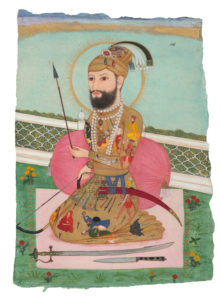
From the sixteenth to eighteenth centuries in India under the influence of the Mughal empire, miniature painting evolved into a distinct and opulent art form. Small in scale and representing stylized visions of courtly life, these paintings served as early modern advertising for the peacock throne and its realms.
Despite their small size, miniature paintings are remarkable in the miniscule detail they capture: the sheen of pearls and delicate softness of a maharānī’s veil or the emerald and ruby-embellished fingers of a māhārājā, resting upon his sword. These imperial images were at times painted specifically to evoke a hierarchy of sacred kingship. At other times, they represented the aspirations of their subjects, and at others, presented everyday scenes, albeit quite literally brushed ten times over with gold. Gold foil was a standard material used to paint halos and clouds hovering over the emperors.
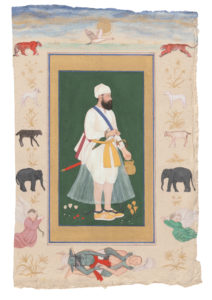
Jatinder Singh Durhailay’s solo exhibition “Free Flowing Forms” (November-December 2023) at The Artist Room in London draws on this tradition of meticulously framed figures standing in profile, but with the welcome distinction that the figures one encounters in his paintings are recognizable as the faces of people one may pass on the street. And in place of scenes of singing courtesans, pious Sūfī saints and emperors with an imagined audience of global kings, Durhailay presents more personal, everyday scenes, as from a gurdavārā, where a group of friends enjoys a dip in the sacred pool.
As a Pakistani millennial, I grew up with Instagram as my primary mode of consumption for all things related to art. I began following Jatinder’s Instagram handle when I was looking for inspiration as a miniature artist in training myself. Before I met Jatinder, I had formed an image of the man behind the art. When we met in Oxford, he was singing kīrtan with a dilrubā, which literally means ‘heart-ravisher’ or even ‘one quarter of a heart’ in Persian. The instrument entered the north Indian musical scene in the nineteenth century and became a prominent mainstay in Sikh sacred music. One can spot this instrument in Brothers from Leeds, a sketch of three turbaned youth offering kīrtan. The figure on the far left plays dilrubā, while the figure in the foreground arrests the viewer’s gaze with his hands dancing upon the joṛī.
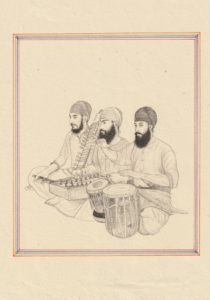
Jatinder is a practicing Sikh, and his devotion to his faith is reflected in the vibrantly-pigmented artwork of this exhibition. The solo show presents a mix of paintings and sketches. Breaking away from the traditional scale of miniature painting, he also includes a few larger paintings that draw on a more traditional style of representational images. Profiles of turbaned Sikh men on washes of Malachite—a recurring background colour for many portraits—feature prominently, with every wispy strand of hair from the beard and nape painted with the finest brushwork.
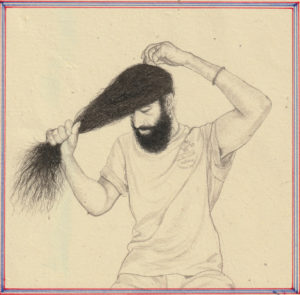
Hair plays an integral part in the lives of the people Jatinder paints. For Sikhs, allowing one’s hair to grow is essential to showing devotion. In one monochrome self-portrait sketch, Jatinder may be seen combing his long and dark hair or kes. The long black fibrous threads of the beard and mustache add a softness to the monochrome palette. It is a moment frozen in time of an everyday occurrence in Sikh life, free from ornate clothing or stylized anatomy. The subject wears a loose t-shirt and jeans, his kaṛā hanging loosely around his wrist. One can almost feel the pendulum swing of the bangle around the bony arm as the hand moves back and forth, combing his hair. In a sketch for the painting titled Bathing under the stars and moon, three friends take a dip in a sarovar, their hair knotted at the top of their heads. A figure on the bottom left has his hair down, cascading and draping across the rippling surface of the water.
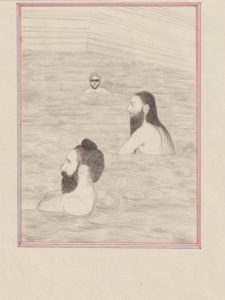
With a good-natured shrug and easy smile, Durhailay told me that his academic training is in large-scale oil paintings. Born in 1988 in London, he received a B.A. in graphic design from the University of the Arts London in 2011. He recounted formative visits to the Victoria and Albert Museum as a child, where he saw Sikh culture represented in paintings. This exposure to visual and other aspects of material culture left a lasting impression, inspiring him to teach himself the technically challenging tradition of Indian miniature painting.
Jatinder is quite particular about the technical aspects and craft of this tradition, preferring to use natural stone pigments where most modern miniaturists resort to gouache. He sources these from Rajasthan along with small brushes and gold leaf. The frayed edges of the wāslī or handmade Indian hemp paper, traditionally used by the artists’ ateliers—as seen in Johanna’s cyclamen—lend an element of verisimilitude to the small still life plant sketches, as if paused in the process of coming to life.
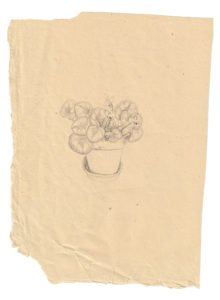
Jatinder has succeeded not only in producing an extensive and varied body of work, but also in redefining his chosen genre of painting with his remarkable capacity to tell his story with his art. An earlier painting titled Akhri Fateh is an image of his father on a background of swirling flowers. This exhibition is dedicated to him. Jatinder offers fresh images reconciling traditional motifs and techniques with scenes from contemporary Sikh life. Durhailay’s art sensitively highlights core Sikh values, brought to life in bright pigments: devotion, equality, perseverance, and charity.
“Free Flowing Forms” is a riot of colours and motifs. Classical decorative miniature motifs exist harmoniously alongside snapshots of urban Sikh life, as in a warrior princess in Adidas sportswear. The characters and overall effect of the paintings remind me of a Diljeet Dosanjh music video. A pop music icon, Dosanjh proudly wears his turban in an industry infamous for westernizing the appearance of its artists; similarly in Durhailay’s art, the traditional and contemporary, sacred and sporty cohesively inhabit the same canvases, reflecting the multidimensionality of contemporary Sikh identity. By situating the contemporary within traditional, Jatinder uses the past to engage the present as much as he uses the present to engage the past.
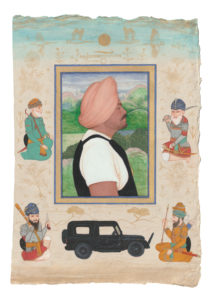
By way of conclusion, I reproduce Jatinder’s answers to three questions I posed to him after viewing his exhibition. “Free Flowing Forms” introduced me to a way of life I only had a vague idea about, filling me with the utmost respect and the curiosity to learn more. For this, I will always be grateful.
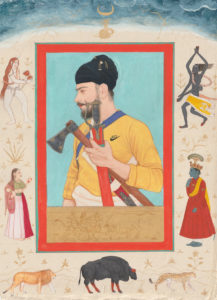
How does Sikh culture inform your work as an artist?
Sikh culture is an intrinsic part of my life. I was born into a practicing GurSikh family, so my education in Sikh culture began with the daily life and actions of my parents. Behind their example is a long lineage of Amritdhārī Sikhs across many generations of my family. Growing up in Britain, I was always fascinated to hear sākhīān or tales about the Sikh lifestyle and history from my grandmother, who would visit us almost every year from India. I was therefore never far away from my roots in Sikh culture and teachings. I would regularly receive beautiful books about the Sikh Gurūs, as well as comics published by Amar Chitra Katha, from my parents and grandparents. These have influenced me greatly. My paintings reflect my own truth, and I feel they convey an accumulation of life experiences across time. Although their subject matter largely focuses on Sikh culture, I believe it is a diverse and vast subject, and that I am only at the beginning of my journey.
The green of malachite features in many of your paintings, either in borders or background washes. What does this color choice signify for you?
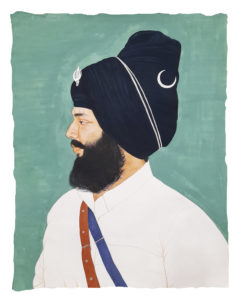
The colour malachite holds a special place in my palette. Colours in general are very meaningful and personal for me, especially those that are naturally derived. Before I begin a painting, I look to the colours for inspiration, and then put them together to produce the feeling I so desire. Colours are like rāgas: they hold a spiritual place in my life. They express what is hard to put into words, like the warmth of Rāga Bilāval on a cold, wintry day, the strength of rain dancing with thunder and lighting as Mālkauns opens its showers on Earth, and the soothing calm of Bhopālī, reflecting the beautiful summer sun. Malachite, to me, is a soothing green, viewing which, I feel as if a balm has been applied to my mind; it recalls to mind the Panjābī words sītal and shānt.
What do you most hope viewers of your exhibition will take away from your paintings?
I really enjoyed the fact that at my first solo exhibition in the summer of 2022—titled ‘Let’s have (a) look then’—at The Artist Room Gallery London, many people could see themselves in my work. For some it was in The Goddess Chandi’s representation of strength and beauty. For others it was in The Chakravati Man, a youthful Sikh male from Punjab adorned in a beautiful Indigo turban. My work requires a lot of patience and skill. Using my God-given hands, I am very content that my paintings are not traced or copied from existing works. Rather, they explore the Indian miniature painting tradition’s age-old art form, continuing a visual language bearing new creative fruit today.
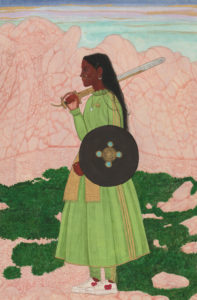
_____
Harram Khurram
